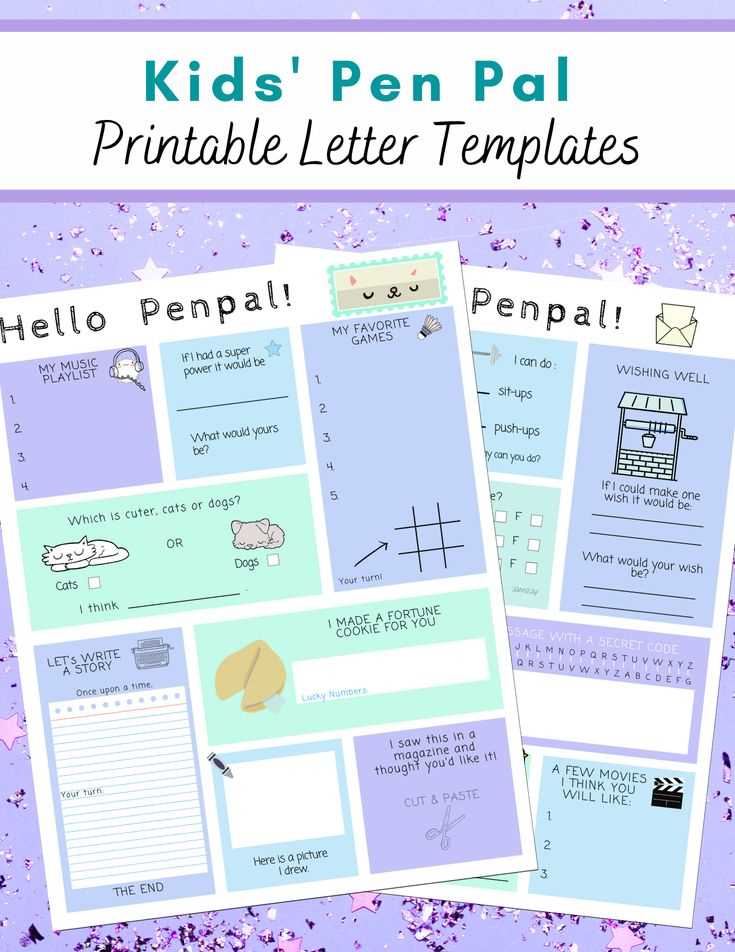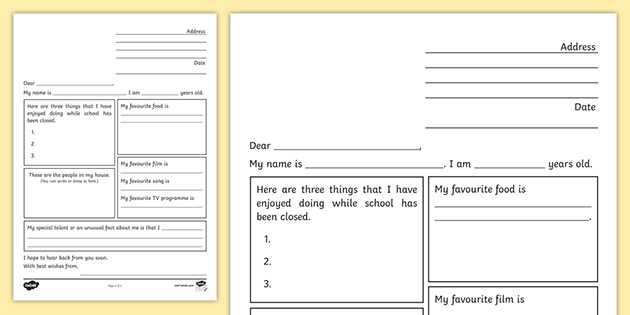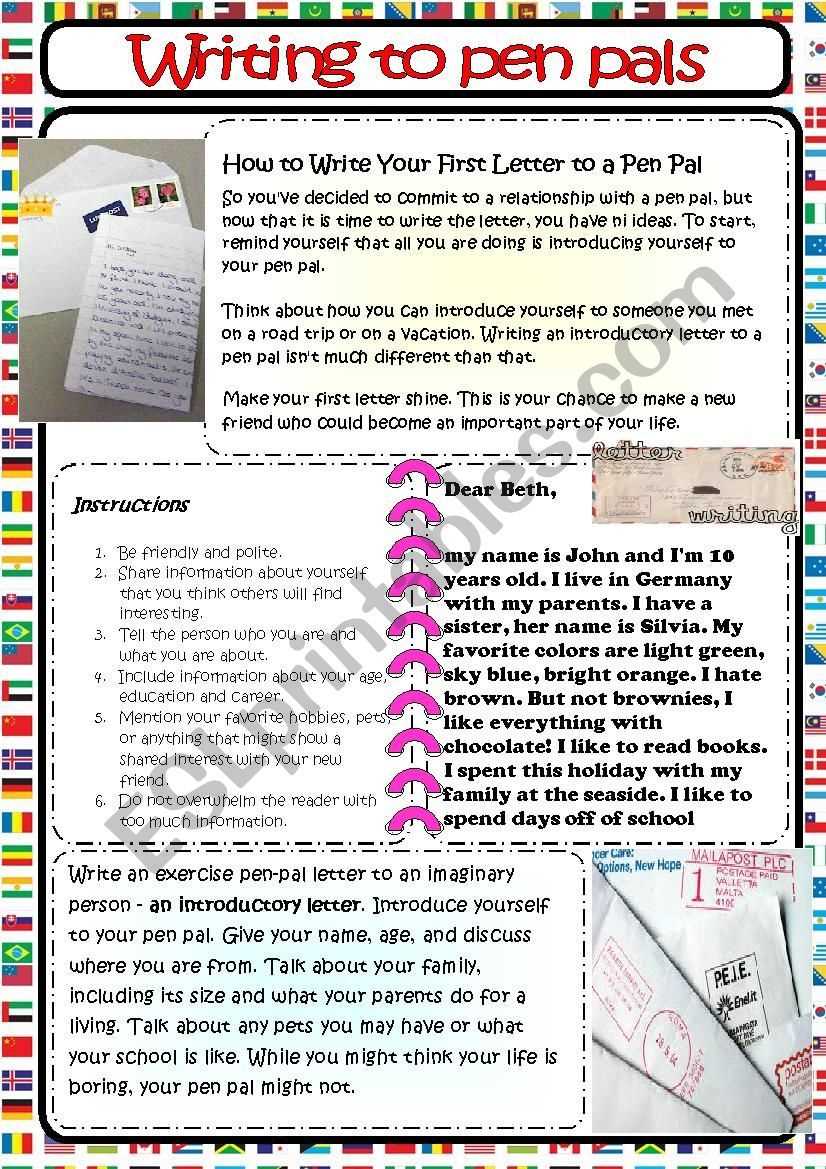Template for pen pal letter

Writing a pen pal letter can be a fun and meaningful way to connect with someone from another part of the world. Start by introducing yourself briefly, mentioning your name, age, and where you live. This gives your pen pal a snapshot of who you are right from the beginning.
Next, ask open-ended questions that invite conversation. Instead of simple yes-or-no questions, try asking about their hobbies, family, or favorite places. This shows interest in them and makes the letter feel more personal. You can also share your own thoughts and experiences to keep the conversation flowing.
Don’t forget to express your excitement about the exchange. Pen pals enjoy receiving letters that reflect genuine curiosity. Finish your letter by looking forward to hearing back, maybe even suggesting topics for the next letter. A strong closing line leaves your pen pal with a sense of anticipation for the ongoing conversation.
Remember, the key is to keep the tone friendly and inviting while keeping things easy to understand. With this structure, you’ll ensure your letter feels welcoming and encourages an ongoing exchange of thoughts and experiences.
Template for Pen Pal Letter
Start with a friendly greeting that reflects your relationship. Use the recipient’s name to make the letter personal, like “Dear Sarah,” or “Hi John,.” This sets a warm tone right from the beginning.
Introduce yourself briefly if it’s your first letter. You can mention where you’re from, what you’re doing, or a few personal details that give the reader a sense of who you are. For example: “My name is Mark, and I live in a small town in Ohio. I’m currently studying architecture and love hiking on weekends.“
Ask open-ended questions to keep the conversation flowing. Questions like “What do you enjoy doing in your free time?” or “Tell me about the best book you’ve read recently!” show that you’re interested in getting to know them. Make sure these are questions that invite stories, not just yes or no answers.
Share something personal or interesting. Talk about a recent event in your life, a new hobby you’ve picked up, or an adventure you’ve been on. For instance: “Last weekend, I went camping in the mountains with a group of friends. The view from the top was incredible!“
Respond to something they might have shared in their previous letter if you’ve already been in touch. This keeps the conversation connected and shows that you care about their thoughts. For example, “I remember you mentioned you’re learning how to play the guitar. How’s that going?“
Close with an invitation for them to share more. Encourage them to write back by saying something like, “I’d love to hear about your travels next time. What’s your favorite place you’ve visited?” This keeps the door open for more conversation.
End with a friendly sign-off. You can keep it casual with “Best wishes,” or “Talk soon,.” Then, sign your name to personalize it even further.
Choosing the Right Greeting for Your Pen Pal
Selecting the right greeting sets the tone for your letter and reflects your relationship with your pen pal. A friendly and thoughtful greeting will make your pen pal feel valued and comfortable from the start.
Formal vs. Casual Greetings
If you’re writing to someone you don’t know well yet, it’s better to go for a neutral greeting like “Dear [Name],” which is polite without being too stiff. As your relationship grows, you can opt for a more casual approach like “Hello [Name],” or even “Hi [Name],” depending on how you feel about the tone of the conversation.
Personalized Greetings

Adding a personal touch can make your greeting feel warmer. A unique greeting like “Greetings from [Your City]” or “I hope this letter finds you well” makes the interaction more personal. It shows you care enough to make the communication more engaging.
Adjust your greeting based on the tone you want to set for the rest of your letter. A friendly and respectful tone will help build a positive connection from the first sentence.
How to Introduce Yourself in a Friendly Way
Start by sharing your name and a few details that make you approachable. Mention where you’re from, but keep it brief. You don’t need to dive too deep into personal history–just a hint of who you are and where you come from is enough to break the ice.
1. Keep It Simple
A simple greeting and your name go a long way. For example: “Hi, I’m Sarah from Chicago. I love reading and exploring new places!”
2. Add a Personal Touch
- Share a hobby or interest that reflects your personality. It could be anything from baking to hiking.
- Mention something unique but light-hearted, like a favorite show or a fun fact about yourself.
- Let them know what you enjoy doing during your free time, as it invites common ground for future conversations.
Avoid overwhelming your pen pal with too many details too soon. Focus on a few details that invite curiosity and make you seem approachable.
What to Share About Your Hobbies and Interests

Share what truly excites you–activities that bring you joy or let you relax. Focus on the specific things you enjoy, whether it’s a creative pursuit like painting or something more active like hiking. The goal is to offer your pen pal a glimpse into your daily life and passions.
Be Specific About Your Hobbies
Rather than just saying “I like reading,” mention the types of books you enjoy. Do you prefer fantasy, mystery, or historical fiction? Or maybe you’re into non-fiction books about personal development or technology? Specific details make your hobbies more interesting and relatable.
Share Your Recent Projects or Goals
If you’re working on something right now, like learning a new language, building a model, or writing a novel, include it in your letter. Your pen pal might find these details inspiring and could offer their own ideas or experiences in response. Talking about your current goals adds a dynamic aspect to your relationship.
| Hobby | Why It’s Interesting | Current Focus |
|---|---|---|
| Photography | Capturing moments and learning new techniques | Experimenting with lighting and composition |
| Cooking | Trying new recipes and perfecting flavors | Mastering Italian cuisine |
| Yoga | Relaxing the body and mind, improving flexibility | Practicing mindfulness during sessions |
Showing enthusiasm for your hobbies makes the exchange feel more genuine. Be open about what makes them special to you–your pen pal will appreciate the authenticity and might even share their own experiences with similar interests.
Asking Meaningful Questions to Keep the Conversation Going
Ask questions that encourage the other person to share personal stories or deeper thoughts. Instead of generic questions like “How are you?” opt for ones that tap into emotions or experiences. For example, ask, “What was the most memorable trip you’ve ever taken?” or “What book changed the way you think?” These questions open up opportunities for rich, engaging answers.
Go Beyond Yes or No
Frame questions that require more than a simple “yes” or “no” response. “What’s been the highlight of your year so far?” invites a thoughtful reply, while also giving you a chance to learn what matters to your pen pal. Avoid closed-ended questions that limit conversation flow.
Ask About Passions and Dreams
People love talking about what excites them. Questions like “What’s something you’ve always wanted to learn?” or “If you could spend a day doing anything, what would it be?” help build a connection based on shared interests or aspirations.
By asking meaningful questions, you open up paths to deeper, more personal conversations that keep both sides engaged and invested.
Closing Your Letter Warmly and Thoughtfully
End your letter with a personal touch that reflects your relationship with the recipient. Keep it simple but sincere, showing that you value the connection you’ve made through your words. Consider including a brief, thoughtful sentiment that ties back to the content of your letter or a specific detail shared earlier in the correspondence.
Be Specific in Your Closing
Rather than opting for generic phrases like “Best regards” or “Sincerely,” offer a closing that feels natural to you and relevant to your conversation. If you’ve discussed shared interests or future plans, mention them. For example, “Looking forward to hearing about your next trip” or “Can’t wait to hear more about your new book club.” This reinforces your genuine interest and leaves the door open for continued communication.
Choose a Personal Sign-off
A personal sign-off can be just as meaningful as the rest of your letter. Whether it’s a warm “Take care” or something unique to your relationship, make sure it reflects the tone of your message. If you’re close to the person, you might use “With warmest regards” or “Sending you all my best.” For more casual or friendly relationships, something like “Talk soon” or “Warmly” adds a light touch without feeling too formal.
Finally, don’t forget to thank the person for their time or mention how much you appreciate their continued friendship. This small gesture helps reinforce your gratitude and creates a lasting positive impression.
Formatting Tips for a Neat and Clear Letter
Focus on consistent spacing. Leave at least one line of space between paragraphs to give your letter room to breathe. This helps in separating ideas and makes it easier to read.
- Use a standard font like Arial or Times New Roman. These fonts are easy to read and maintain a clean look.
- Stick to a font size of 12pt. It’s large enough for comfort but not too overwhelming on the page.
- Align your text to the left. Left-aligned text is the most readable and looks more professional than justified text.
Don’t forget about margins. A 1-inch margin on all sides of your paper ensures your letter isn’t too cramped and gives it a polished appearance.
If you want to emphasize a point, use bullet points or numbered lists. Lists break up large blocks of text and make key information stand out.
Keep your sentences clear and concise. Avoid long, complex sentences. Short sentences are quicker to read and less likely to confuse the reader.
- Be mindful of paragraph length. Try not to go over five sentences in a single paragraph.
- Use simple punctuation, and avoid overusing commas. A period or dash often works best to separate ideas.
Finally, proofread before sending. Errors in grammar or spelling can disrupt the flow of the letter and create confusion. A quick review ensures clarity and professionalism.